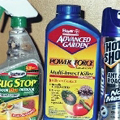Forum Replies Created
-
AuthorPosts
-
CNDNGirl
ParticipantA quick update from me –
Started getting bitten (infestation in family home) when I can home for Christmas this past year. Started taking these salt tabs (based off of what I read here) after 20 days. Took them for just under two months religiously. I was also daily vaccuuming/cleaning, laundering, washing, keeping things in bags, etc. But I seemingly got rid of them (a month with no bites)!
That is, until COVID hit and I moved back home where they hadn’t been entirely eradicated. Got them again. Started taking the salt pills again (I would also take garlic and a daily cold vitamin too – FYI) for a few months. I was also stepping up treatment because we bought a steamer and I would steam my mattress, office chair, and floor around my bed daily (I think the steamer is KEY). I’m now been “clear” again for over a month.
So — all that to say, I’m not sure if the salt pills (Natrum) did anything because I combined it with so many other things. I think the key is just to do treatment every day (cleaning, washing self, steaming – highly recommend).
My dad just got a bite today after months of nothing. Feeling disheartened because I thought we had kicked them for good. *sigh* back on here to try and find more ideas.
Good luck to you all 🙂
CNDNGirl
ParticipantI have used a handheld steamer for the past while now. I steam the floor, the bed, the pillows, the chairs. The steamer can reach over 200 degrees and I think it’s been helpful in killing them. It’s important to hold it over areas long enough for the heat to penetrate and kill. So hard to tell as my family house’s infestation is now just affecting me and my room, but my number of bites has reduced.
If you have the time to use it and the money to spend on it, a decently-priced steamer can make a huge difference (at least in my experience).
CNDNGirl
ParticipantHi there –
I think them coming back is a possibility, so it’s important to be as diligent as possible when going through your stuff. I’ve done a lot of research into academic articles related with the red poultry mite, and it seems as though you don’t have that (maybe the northern fowl mite), but still some of this info may help.
First of all, it’s important to know that once mites have had a blood feed, they can live for up to 9 months on that feed (again, this is for the red mite). From a study:
“As a nest parasite it only comes to the host to feed, but it must do that repeatedly; the two nymphal life-stages both feed, and the adult female has to feed for every batch of eggs.
Chicken mites are well adapted to host absence and can survive long periods of starvation (up to 9 months) if they are protected from desiccation.”
So if there were mites that fed off you or your dog and then just lay dormant, it is possible they could still be alive.
As a precaution, I would wash everything that comes out of those bags. Wash on hot water and put Borax into the washer along with your regular soap. Then do a long dry cycle in case the washing doesn’t kill anything. For things that can’t be washed, bag them and put them in the freezer for a few days just to be sure. And definitely I would keep up and do a deep clean with heavy vacuuming, washing (I use Pinesol or Lysol) of walls and floors, and keeping up with laundry.
I hope some of this helps! Good luck.
– J
-
This reply was modified 5 years, 2 months ago by
CNDNGirl.
CNDNGirl
ParticipantThanks for this 99Lives. I’m sorry that nothing has been working for you either. I’m mostly using oils and herbal things as well, as well as enzyme spray.
I’m curious – what is this Triamcinolone Acetonide Cream 0.1% that you mentioned? What was it prescribed for? Have you found it to be effective?
Thanks
– JCNDNGirl
ParticipantIt’s a good thing you acted quickly. I would also wash or spray down your shoes and the bathroom with Pinesol/Lysol. They have been known to survive showers by clinging onto the tub, so doing a thorough scrub will help.
Typically, a dryer running on high heat for at least 30 minutes will kill them. To be thorough, wash all the clothing in HOT (using Borax if you have) and drying all the way through is best. And believe me – you want to be as thorough as possible with this!
Good luck.
CNDNGirl
ParticipantI am so sorry to hear about what your friend is going through. It is absolute HELL on earth these bird mites.
I have done lots of research on these things, both those websites such as these and through academically-published scientific articles, and based on that I can say that BMs have been known to live up to 9 months without a blood feed, so her going away for 1 month wouldn’t have done much. Also, they can be so small as to live in someone’s pore and although they don’t typically LIVE on the host throughout the day (preferring to go off and hide during the daytime and crawl back on at night), they can and have bene known to in some cases. They do also like long hair (I, personally, am getting bitten mostly around my neck and scalp) so cutting/shaving her hair is always an option, albeit a pretty drastic one for most.
I wonder what her daily bathing/cleaning routines are? As well as any supplements she has taken? Some people have looked to change their internal body make-up (nothing drastic – garlic pills and immune boosters and salt tabs for some) to try and make their blood less appealing.
I’m so sorry for your friend, but there is hope. Definitely look through this website and on others for more guidance.
CNDNGirl
ParticipantI will also note that I have seen these pills come in many other concentrations but I think the 1M is the one you need. We were lucky to find them in a local health store, but I’ve only seen them in that concentration in that one place (in Ontario, CAN, for reference).
CNDNGirl
ParticipantUPDATE: I posted above. I have been taking these pills since Jan 27th (so just over 2 weeks). It is the 1M concentration, and I dissolve 5 pills 3 times per day under my tongue.
At first, I still kept up with my daily bathing, laundering, cleaning routine. I pretty much only get bit on the neck and scalp, and after taking them I didn’t find any new bites for almost 12 days. I let the routine fall away just a bit (didn’t daily shower once or twice). Now, 17 days or so into it, I have had 1 more bite since that initial one. I am discouraged that it hasn’t been a “miracle fix” that the person above posted about, but I’m continuing to take them.
My mom has had similar results — still a few bites but fewer than before. She was at her drs and mentioned that she was on the salt tabs and the dr said that people should only take them for a month or two before taking a break from them. I haven’t felt any adverse effects, but perhaps it’s not perceptible.
So — not sure what to say. I know the life cycle from egg to adult is around 10 days, so I knew that there might be more bites around that time. I feel as though I can still feel them crawling at times but I didn’t have a big infestation to begin with.
So — it’s kind of working? Again, this is me being a few weeks into it.
CNDNGirl
ParticipantMy mom and I (both affected, living in different places now) have ordered these based on your recommendation and were able to get the correct dosage. I can’t wait for mine to arrive and to start using them. For anyone else doing this as well, just read up on the side effects of natrium muriaticum, as it may cause negative effects for some. Just something to bear in mind.
I’ll update once I start using them regularly. Thanks again for sharing this — it gives us some hope.
– J
CNDNGirl
ParticipantHi Amanda,
Just know that you and your husband are not alone. I hope that gives you some comfort. First of all, I would say that if you still have chickens, you need to get rid of them and completely contain and exterminate (and remove) the coop. In the book “The Year of the Mite”, having chickens is what made the author first become infested, and how it continued for so long.
Definitely call around and speak to exterminators. But you need to ask them SPECIFICALLY if they have dealt with bird/poultry mites, and ask what chemicals they use and what their follow-up protocol is. There are guidelines on this website for talking to pest control operators.
A lot of it comes down to daily vaccuuming/spraying of lysol or other strong cleaners, daily showering and scrubbing with neem oil and tea tree, and daily laundering. I have been dealing with them for some time (minor infestation – a few bites occassionally) but I have an extremely strict protocol and I bag up all my linens and clothes and don’t wear them again until they’ve been in the dryer for at least 30 minutes.
There are lots of different things that people have done. Read everything on this forum, develop a plan that makes sense for your family, and implement it. But definitely call around to local PCOs and start talking to some that have experience specifically with this type of mite.
Good luck! Let us know how it goes.
– JCNDNGirl
ParticipantLet us know how you get on. Definitely try the things posted on this forums and on the site. Good luck.
– JCNDNGirl
ParticipantRead everything on this forum and start getting into a daily routine. Contact local exterminators and ask specifically if they have experience with bird mites. See if you can get a sample (super tough to do) by having a lint roller or sticky tape nearby, and if you feel crawling, then see if they come up on the tape.
CNDNGirl
ParticipantI’m not entirely sure, but I do know that adult mites that have had at least one blood feed can live for up to 9 months without any more feeds. So if your relatives are only leaving for a few months, unless they are SUPER diligent and fog/spray the heck out of it just as they leave (and/or have professional crews come in after they vacate to spray – those who have experience with mites), they may not die.
I can’t speak to whether they would move to find other hosts or not. I’m not sure.
CNDNGirl
ParticipantThanks for sharing your story Jim. Any suggestions help! I’m glad you’re free of the pests now
– JCNDNGirl
ParticipantHi there,
I’m glad you found this group – you’re definitely not alone!
This is what I personally do, and I have found it to be “working” most of the time (the number of bites I find each day is going down). I will be thorough, since I know some people appreciate that.
AM – wake up, strip my bedding immediately, put in a plastic bag that I seal and put outside (I live in a cold climate, so I’d like to think this may help). I have a vinyl cover to my pillow and mattress, and I spray it down with an enzyme spray (I use Lice Squad’s enzyme spray) and with lysol. My bed is pulled away from the walls and I have a circle of borax encircling it.
I go to shower immediately. I put the clothing I wore in the night into another bag that I seal. In the shower, I scrub my body with a loofah and Dawn dish soap (that I leave on my body for a bit before rinsing — it might be too hard for some people), tea tree oil shampoo, and an apricot/neem oil face scrub. I have also done a few lice treatments along the way since I find I get bitten mostly around my neck and scalp). I hydrate with a eucalyptus moisturizer. I take a garlic and an immune boosting pill each morning with breakfast.
I check my body for new bites and record any new ones (I find it important to track this).
PM – dry my sheets in the dryer for 40 minutes. I also dry my clothing before I change back into it. Wipe down the vinyl mattress again with lysol. Every other day (because I can’t every day), I vacuum my room and wash down everything with Pinesol. I run a heater in my room that really dries everything out. I smother my both with neem oil (smells TERRIBLE, but lots of research shows it works) and Aquaphor (basically vaseline). I change into comfy clothing right from the dryer. I put my sheets on, and right before I go to bed, I spray my socks with lysol (as to not drag anything into bed). I also sleep with my side lamp on, because I read a study that tested mite activity with 23h darkness vs 12h darkness in a day, and it said:
“Our findings demonstrated that prolonged darkness significantly promoted the proliferation levels of D. gallinae, resulting in increased number of mites and eggs in the rearing system. The promoted population growth of D. gallinae was found to be related to the increased feeding rate, engorgement level and oviposition level of mites under prolonged darkness. The egg hatchability, the survival rates and the duration of life-cycle of D. gallinae were not affected by the light regimes.”
…so in my mind they are less active when lights are on.
That’s what I do. It’s a lot to manage, and I am very lucky to live somewhere cold and in a room that has hardwood floors, but it’s a constant slough until they’re gone.
I hope some of this advice will help!
-
This reply was modified 5 years, 2 months ago by
-
AuthorPosts




